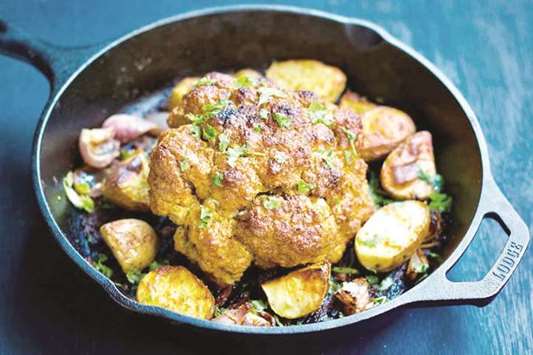Weekend winter mornings are a great way to spend quality time with friends and family. Then comes the breakfast or the brunch which again unites the family. Growing up in Delhi, India, in a Punjabi family, I have always enjoyed steaming hot parathas with dollops of butter on them. Whether it is cauliflower, potato, lentil, spinach, fenugreek or the most exotic broccoli or rice parathas, I love them all. The paratha that I liked the most is the cauliflower. This is a vegetable which is easily available fresh and is in season. I am sure that you all agree with me that seasonal vegetables taste better when they are in season as compared to the cold-storage ones which are available all year round. Talking about cauliflower – it is a vegetable native to the Mediterranean region, especially the northeastern portion of this region in what is now Turkey. Its history dates back to 2,000 years and the cauliflower can be either loose curd (head) or the curd (head). Many countries focus on the loose curd which lacks the large compact head and features long stem and leaves.
Cauliflower is a member of the cruciferous vegetable family along with broccoli, cabbage, kale, Brussels sprouts and some other less common varieties. Recent studies suggest that cruciferous vegetables are an excellent source of natural anti-oxidants due to their high levels of various phytochemical, as well as good source of essential vitamins, carotenoids, fibre, soluble sugar, minerals and other essential compounds. As a matter of fact brassica vegetables are the largest source of phenolic compounds in the human diet.
The most commonly consumed variety of cauliflower is the white and many people consider cauliflower not as healthy as its green counterpart – broccoli which is not really true in all aspects. White variety of cauliflower is just as rich in nutrients as the green cruciferous vegetables. There are four main classification of cauliflower based on its colour – white, green, purple and orange. The floret part of cauliflower is what most of the people eat, however the stem and leaves are also edible and are especially good while making a soup or stock.
Due to its closed structure, it is important that you prepare the cauliflower properly before you cook it so that no foreign particles are present. First remove the outer leaves and then separate the florets into smaller floret at the base where they meet the stalks. Trim any brown colourations that may exist on the edges. Dip the florets in warm salt water to remove any insects or foreign particles. Blanch them in salted waiter again to cook the florets and retain the white colour and then dip them in ice bath to stop the carry over cooking and retain the crunchy texture of cauliflower. Always remove cauliflower contains phytonutrients that release sulphur compounds especially when heated. These odours become stronger with increased cooking time, so to minimise the odour and retain the vegetables crisp texture, cook the cauliflower for only short time.
You can choose the cooking method you like for cauliflower but the one I prefer the most is healthy sauté after a quick blanch in salt water. I always keep three things in mind while cooking my vegetables first is the minimal heat exposure, second is least possible cooking time and the last is minimal necessary seasonings required to enjoy the real taste of vegetable rather than the seasoning.
India and China are the largest producer of cauliflower in the world which accounts to ¾th of the total production in the world.
While selecting cauliflower, choose a clean, creamy white, compact curd in which the bud clusters are not separated. Spotted or dull coloured cauliflower should be avoided, as well as those in which small flowers appear. Cauliflower heads protected by many think green leaves are better protected and will be fresher. The size is not related to its quality, so choose the one that best suits your requirements. Cooking tip: Add few drops of lemon juice or vinegar while blanching the cauliflower to enhance and protect its colour.
Cauliflower
and Turkey soup
Ingredients
Cauliflower florets 200gm
Turkey breast 100gm
Olive oil 30ml
Garlic clove 2-3 no
Celery stalk 1 no
Noodles 50gm
Carrots 30gm
Green peas 30gm
Salt to taste
Black pepper to taste
Garnish
Cilantro leaves to garnish
Method
Trim and soak cauliflower florets in salted water and keep aside
Heat oil in a heavy bottom stock pot and sauté chopped garlic cloves
Once the garlic is light brown add chopped celery and sauté till celery is translucent
Add cauliflower florets, diced carrot, green peas and diced turkey breast and sauté till the florets are browned
Add water and simmer the ingredients over slow flame for 5- 8 minutes
Add noodles and simmer again for 5 minutes and adjust the seasoning with salt and black pepper
Serve hot in a soup plate garnished with cilantro leaves and choice of bread on the side.
* Chef Tarun Kapoor,
Culinary Mastermind, USA. He may be contacted at [email protected]

HOT: Cauliflower and Turkey soup often served hot with cilantro leaves.tPhoto by the author


